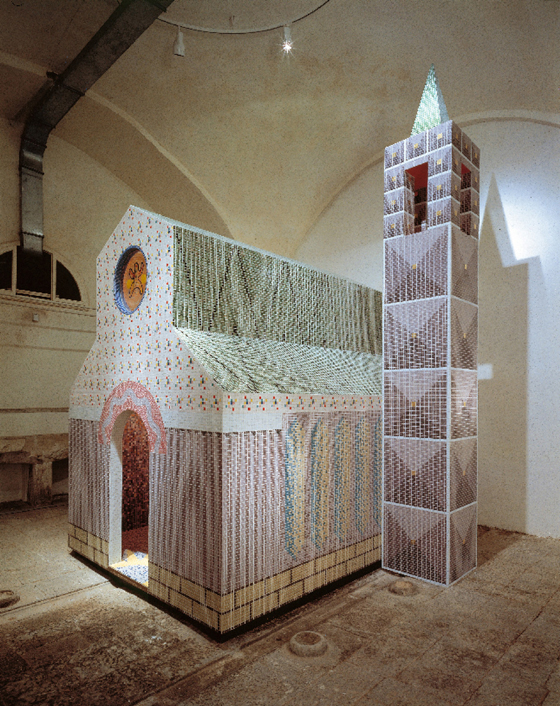The Milan Four: Alessandro Mendini
Text by Simon Keane-Cowell
Zürich, Switzerland
17.05.11
In the second of our series of four interviews with four leading design figures from this year's Milan Furniture Fair, Architonic meets Alessandro Mendini – designer, architect, writer, theorist and all-round provocateur. Mendini, who turns 80 this year, discusses, among other things, the importance of irony, the increasing lack of polemic in design, and why certain detractors of the 1980s postmodern Memphis movement might be talking 'bullshit'.
There are a number of design objects that have, over the last couple of decades, been accused of giving design a bad name. Philippe Starck's 'Juicy Salif' lemon squeezer, for one, has often found itself in the dock, placed there by various design practitioners and commentators for alleged crimes against function-led form. Perhaps the expressive, tripodal object's only 'true' crime was its commercial success, achieving for a period of time an almost iconic status among consumers who, for many of Starck's peers, had too much money and not enough of an understanding of what good design means.
'An object is something that tells a tale,' argues Alessandro Mendini. 'You can almost read it, as if it were literature'; shown here, 'Mobili per Uomo' ('Furniture for Man') for Bisazza, 1997–2008
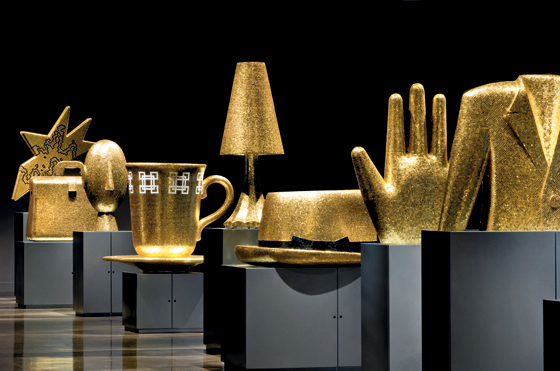
'An object is something that tells a tale,' argues Alessandro Mendini. 'You can almost read it, as if it were literature'; shown here, 'Mobili per Uomo' ('Furniture for Man') for Bisazza, 1997–2008
×Another design that manages to divide opinion as to its merits is Alessandro Mendini's 'Anna G' corkscrew for Italian manufacturer Alessi. The anthropomorphic kitchen-drawer utensil is playful and emotive for some (precisely what design should be, they argue), while anathema to others. ('Kitsch', cry the modernists.) Personally, it's not something that I would choose to own, but to dismiss the piece as mere whimsy is to do it, and by extension Mendini, a disservice. For this mundane object, like all of the prolific designer's work, has a radical aspect to it, even if it comes in innocent sheep's clothing.
The Milan-born Mendini, without whom the narrative of Italian design would be a lot poorer, and yet who came to actual design practice relatively late in his career, can be credited with, among other things, his editorship of the opinion-forming magazines 'Casabella', 'Domus' and 'Modo' in the 1970s and 80s, several architectural projects, most notably the Groninger Museum in the Netherlands, and his membership, alongside the likes of Ettore Sottsass and Michele de Lucchi, of the radical design group Studio Alchimia, which laid the way for the later and more renowned Memphis Group. Both Alchimia and the Memphis movement, characterised by a historically eclectic and often antagonistic design discourse, embraced irony for polemical purposes, creating objects that challenged the dominance of late modernism, with its claims on rationalism and good taste. It was Mendini and his peers who put the post into post-modern design and things haven't been the same since.
Italian Renaissance: aside from his involvement in radical design groups Studio Alchimia and Memphis, Mendini is former editor of design magazines 'Casabella' and 'Domus', and has completed several feted architectural projects
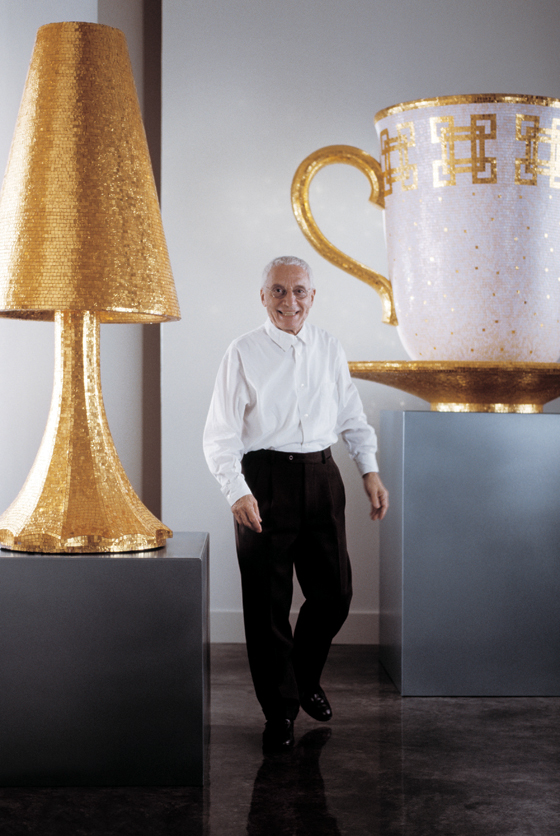
Italian Renaissance: aside from his involvement in radical design groups Studio Alchimia and Memphis, Mendini is former editor of design magazines 'Casabella' and 'Domus', and has completed several feted architectural projects
×I met up the Compasso d'Oro-winning Mendini at the Triennale di Milano, where a selection of his work for high-end Italian mosaic brand Bisazza was being exhibited as an homage to the designer and a celebration of his 20-year collaboration with the company. When I referred to the show as a retrospective, Mendini was quick to correct me. 'Shows…are always to delve deeper into particular themes or certain aspects of my work,' he explained. With Magis having just launched a revisiting of his iconic 'Proust Armchair' – the polychromatic piece of postmodernism has been given the rotomoulding treatment – he's clearly not stopped using design to question design itself, its meaning and effects. And for that we should be glad.
So, sometimes a kitsch corkscrew is more than just a kitsch corkscrew.
'Iconic objects become fixed,' says Mendini. 'But to me the [Proust] armchair is not a crystalised object at all because I'm still researching into it'; shown here, 'Poltrona Monumentale di Proust' ('Proust Monumental Armchair'), 2005
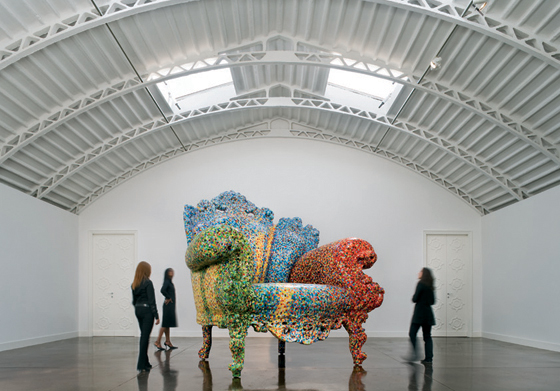
'Iconic objects become fixed,' says Mendini. 'But to me the [Proust] armchair is not a crystalised object at all because I'm still researching into it'; shown here, 'Poltrona Monumentale di Proust' ('Proust Monumental Armchair'), 2005
×.....
How does seeing your work for Bisazza presented here as a retrospective make you feel? Do you take it as a tribute, does it make you reflect...?
These shows are never retrospectives. In a way they are always to delve deeper into particular themes or certain aspects of my work. In this case, the Bisazzas were so kind as to make a present of the show to me. But, to me, this was also a way of experiencing all my past experiences. And that consists of two things: on the one hand architecture, on the other objects. The main part of my work with Bisazza has consisted of architectural work, and that, in association with my firm and with my brother, Francesco.
But these works here are more personal, more private, and have a lot more to do with art itself. There's always some level of ambiguity associated with them, whether they are sculpture or design objects, because actually the base of these sculptures is a cabinet. So they're pieces of furniture. And this collection was added to incrementally, with new objects being introduced year in, year out. The idea was to decorate them with objects that would be characteristic of a man's wardrobe, which was done in a part ironic, part rhetorical way. So maybe I'll continue with a few more objects.
On the point of irony, it can be a powerful form of expression, of rhetoric. Is there enough irony in design currently, or have we lost our sense and purpose of it? Has it become unfashionable?
Irony is quite hard to come by. And that is because irony is something that causes you to laugh at yourself. Not many people are willing to laugh at themselves, because everyone seems to think they are worth more. In Italy, for instance, two of our designers have used irony quite a lot – Bruno Munari and Achille Castiglioni.
In my case, an object is something that tells a tale. So an object embeds a lot of content into itself. You can almost read it, as if it were literature. So, from this point of view, mosaic is a perfect technique because it's a sort of alphabet.
Mendini's irony-loaded 'Furniture for Man' collection for Bisazza confuses the boundaries between sculpture and design. The bases of the works are storage cabinets; 'Giacca' ('Jacket') from 1997

Mendini's irony-loaded 'Furniture for Man' collection for Bisazza confuses the boundaries between sculpture and design. The bases of the works are storage cabinets; 'Giacca' ('Jacket') from 1997
×I think this idea of object as narrative is a really interesting one, and wanted to ask you about some of your older designs that have become so iconic. I'm thinking in particular of the 'Proust Armchair'. When an object becomes so well known, does it lose some of its legibility? Is it not read properly or scrutinized anymore because people regard it as an icon?
It's a fair remark because iconic objects end up sclerotising. They become fixed. But to me the armchair is not a crystalised object at all because I'm currently still researching a lot into it. I'm experimenting with different sizes, different materials, different settings and places, rich and poor versions, so it's still very refreshing to work with it.
I was at a one-day conference in Germany recently, where Matteo Thun and a number of other speakers were asked what the last important movement in design was for them, historically. A lot of them cited Memphis. With Memphis really only coming into being because of Studio Alchimia, I wondered what you thought of Thun's comment that 'Memphis was shit.' That what Memphis produced was 'done after midnight, often drunk' and that the work was completely post-rationalised. And this from a former Memphis member himself.
That's bullshit.
Would you like to expand on that?
Memphis marked an essential change in language and mindset, too, because it marked the transition from modern and postmodern – even if some of the works were created after midnight and when we were drunk. Basically, design afterwards was no longer the same as it had been before. It was a big turning point in history, which made a lot of difference.
Maybe Matteo Thun wanted to sound snobbish or didn't really understand what he was doing.
'Irony is quite hard to come by,' suggests Mendini, 'because irony is something that causes you to laugh at yourself. Not many people are willing to laugh at themselves, because everyone seems to think they are worth more'; 'Guanto' ('Glove') from 1997
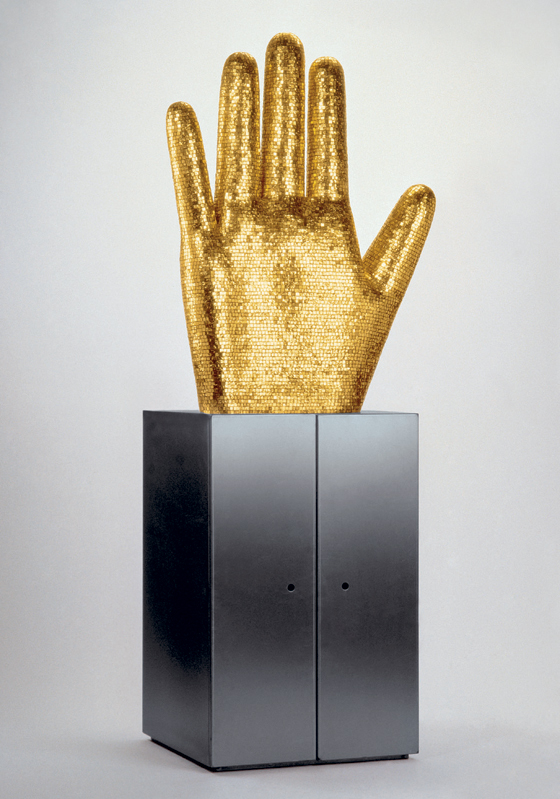
'Irony is quite hard to come by,' suggests Mendini, 'because irony is something that causes you to laugh at yourself. Not many people are willing to laugh at themselves, because everyone seems to think they are worth more'; 'Guanto' ('Glove') from 1997
×I think Memphis was a radical point in design history and it's easy after the event to evacuate it of meaning.
Obviously, these movements were very intense at the beginning. And when they turned into a fashion, they sort of lost their meaning. But even before Memphis and Alchimia, there was another movement that they all stem from. That was radical counter-design. And my magazine 'Casabella' was fully in line with this. And it was a pre-ecological movement.
Who is working in design today in a radical way? Has design lost its political purpose? Can we even talk about design movements anymore or is it all trends and fashion?
I agree that we live in a cynical world, where most people seem to flee from any sort of commitment whatsoever. And everybody seems to have to accept the realistic fact that we live in a violent world. And I hope that something will happen, although I can't see it coming.
'Petite Cathédrale', 2002, Collection Fondation Cartier pour l’art contemporain, Paris
And who would you say is doing good, meaningful work in design, which has something at stake, which has something to say?
I don't like to give names, and I'm not even capable of doing that. For sure, there are a lot of very capable designers with a lot of talent and potential, but this is also a time of marked individualism. Everybody is very individualistic about the work they do. Whereas whatever is new will only come from groups. Historically, it came from groups only. Sure enough, there are a few smart people who do interesting research but I couldn't name them.
I think, for instance, this week we should be looking for people who didn't or couldn't manage to communicate about what they were doing, those who weren't in touch with or couldn't make it through the media. People who are in far away locations, possibly small places: maybe there we'll find someone who's got something to say.
Many young – and not so young – people come and see me. They are sort of bizarre, funny, and they live on delusions and utopias of salvation. And all these people with all these ideas in mind, they are outside of the mainstream. They are not part of the wave of success.
If they do exist on the margins, beyond the realm of commercial design praxis and discourse, how do they then make themselves heard?
I don't know.
Thank you.





